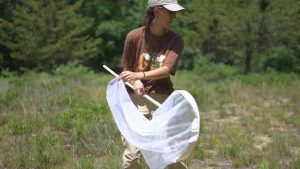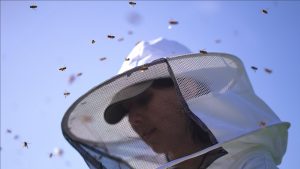Not all bees are black and yellow.
In fact, some are quite the opposite. Some are iridescent blue – shiny, mid-sized, and metallic.
Those blue bees live right here in Connecticut, working alongside the bees we most commonly think about – the buzzing bumblebees, the busy honeybees – as well as a couple hundred other species of bee that can be found in the state.
Some of the bees are itty bitty, or only found in certain areas when specific types of flowers are in bloom. You’d have to know where they are to find them, and when, and you’d have to look very closely to even see them.
That’s what Hailey Baranowski ’24 (CAHNR/CLAS) is learning to do this summer – to see the bees that others may not have seen.
“A lot of the ones that you’ll see the most often of those hundreds of species are the wasps and the bumblebees and your generalists, because those guys are the biggest and strongest. They’re always around,” explains Baranowski, who is studying Environmental Sciences and Ecology and Evolutionary Biology at UConn.
But it’s the little bees, the unusual bees, and the native bees that Baranowski is searching for this summer, empowered by a Summer Undergraduate Research Fund, or SURF, award from UConn’s Office of Undergraduate Research. SURF awards support research or creative projects for undergraduate students of any major and from any campus. The awards are given through a competitive application process where recipients are granted up to $4,500 to pursue their project over the summer.
Baranowski’s SURF project is centered around the conservation areas at Mansfield Hollow, a site owned and maintained by the U.S. Army Corps of Engineers that’s home to notable local bugs and plants, including the frosted elfin butterfly, a threatened species, and the wild blue lupine upon which the butterflies rely.
“There’s just a lot of state-listed species that are managed right on that site,” Baranowski says, but there aren’t any formal records at all of the kinds of bees that can be found there.
“I was looking to do research in an area that they had a gap in,” she says. “So, it kind of made sense for me to go over there.”

Every week this summer, you’ll find Baranowski at Mansfield Hollow, close to the Windham Airport, searching for bees, sometimes on her own and other times with her mentor and advisor on the project, David Wagner, an entomologist and professor of ecology and evolutionary biology at UConn who works at the conservation site.
Her objective in the project is two-fold – first, to survey and record the species of bees she finds at the site, and second, to test the effectiveness of a common bee collection method called a bee bowl.
“Bee bowls are basically just little cups that you fill with water and soap, and it’s kind of like a fly trap but it attracts bees,” Baranowski explains. “They are used a lot in collection methods. They’re a relatively cheap and effective method for understanding what’s living in your area.”
In looking at the existing research around bee bowls, Baranowski found that a lot of investigation had been done into the most effective colors and sizes of bee bowls, but she didn’t find as much on how close or far a bee bowl should be placed from a potential food source for the bowls to be most effective in catching bees.
The conservation area at Mansfield Hollow provided the opportunity to test bee bowls on a variety of landscapes and terrains, including pine barrens, grassy fields, and rockier areas with fewer obvious nectar-bearing plants. Every three weeks when the weather is good, she sets up five separate transects of bowls in the different areas of the site, leaving them up for only a few hours at a time before collecting and documenting the specimens she finds in the bowls.
Her goal is, at the end of the project, to be able to contribute new and novel research into bee bowl efficacy at a time when understanding pollinator diversity is of increasing global concern.
“Providing more detailed research on bee bowls can help other scientists make a call on what kind of collection method they want for an experiment, or what habitats they should focus on sampling in,” she says.
During the weeks that she’s not setting out bee bowls, Baranowski instead goes out with a net, standing quietly as she uses both her eyes and her ears to search for bees that she can catch by hand.
“When you look very closely – especially for a survey like this where a lot of it is just standing and walking super slowly to see if you can see anything flying around or hear anything buzzing around – you’re looking, and the bees are so, so tiny,” she says. “There’s so many that are like that, but they’re specific to just a couple of types of species of plant or habitats. They’re more picky, in that sense.”
Baranowski had even more opportunity to develop her observational skills on a three-week field ecology trip to South Africa in late May and early June. Supported by UConn Experiential Global Learning, students travel with UConn faculty to the Entabeni Safari Conservancy in Limpopo Province, where they learn about native species and ecological systems in southern Africa as well as related management and conservation issues.
While she wasn’t searching for insects in South Africa, during trips out on game drives, and when identifying animals by their tracks, and while learning about traditional uses of local plants, Baranowski found herself engaging in the same kinds of observation that she was doing at Mansfield Hollow – sitting, looking, listening, and thinking, trying to learn from what’s right before her.
“I was collecting along a patch of swamp rose the other day near the airport, and I was like, this just feels like I’m in South Africa again,” she says, “because I’m standing there in silence, watching the bees fly around so that I can try to grab them, and I’m observing. Are they just smelling the flower, or does it look like they’re actually exchanging pollen? I was like, huh, I’m getting better at observing. It’s a good skill to have.”
On the days that she’s not in the field at Mansfield Hollow, Baranowski is in the lab on campus in Storrs, pinning specimens and identifying any species that she can. Other harder-to-identify species are DNA barcoded so that their characteristics can be better defined for the future.
She plans to ultimately donate the specimens she collects through the project to UConn’s Biodiversity Research Collections, where they’d be accessible for research and study alongside the thousands of other samples housed in the collection’s vast library of plants, insects, and other flora and fauna.
“The Nomada genus, especially, as well as some of the other parasitics that we’re looking for, are not really well documented in this area, especially not DNA-barcoded versions of those where we can get confirmation about what they are,” she says. “So, being able to present that to the University will be really rewarding for them to look back on.”
Baranowski, who grew up in Wethersfield, has had nearly a life-long fascination with bees. But like many people, she was initially a little afraid of them.
She learned about UConn’s Beekeeping Club from the Involvement Fair, organized each year by Student Activities at UConn, and she joined the club’s executive board as a sophomore at a time when it was reorganizing post-COVID. More than 100 students are now members of the Beekeeping Club.
“I spent all sophomore year getting the club back going and everything, and I was like, oh my gosh, bees are actually the best ever,” she says. “The second I got my first hive with the club, everything made so much sense, suddenly. It was so perfect.”
Baranowski began living and working at Spring Valley Student Farm last summer, where she helped the Beekeeping Club establish new hives at the farm, a place where hives had been absent for some time.
“Working on a farm made me really realize how important bees were – if there was no food, and nothing for the bees to eat, nothing flowering, nothing of ours would grow,” she says. “Everything that lives and everything that grows, including us to a degree, is because of pollinators and bees.”

Part of her fascination with bees is that she just finds them cute. But she also admires the worker bees and how they seamlessly transition from role to role within the hive based on what the community needs.
She’s also fascinated by natural bee behavior, which differs from how honeybees act when they’re in a human-managed hive.
“So many studies and experiments have been in regular Langstroth hives, or ones that beekeepers use, and their behavior is modified,” she says. “How they act is not the same as in the wild. In Germany, they do a lot of really cool forest bee surveys where they see them doing those characteristics and those behaviors naturally, and they’re so smart. It’s so insane what they can do, especially when we are not interacting with them constantly and putting on that stress.”
When she finishes her undergraduate studies at UConn in 2024, Baranowski hopes to go on to graduate school, where she want to study either native pollinator ecology or bee ecology, specifically. Her SURF grant project has offered her skills that are directly transferrable to what she hopes to eventually do in life, and it’s given her the opportunity to know and learn from Wagner and his colleagues, who are renowned in their field.
And while going to UConn wasn’t initially her first choice, it’s ended up being a really good one, she says.
“I feel like the communities that I found here have just really been so amazing,” she says. “I live and work at the student farm, and the friends I’ve made through Beekeeping Club, and the faculty I’ve met while working on this grant – everyone I’ve met has such strong goals, and they’re such helpful people, and everyone is so kind at this school.
“And I’m sure other universities have nice professors and stuff, but I think we have the best ones, because everyone is actually set out to make sure students succeed.”


